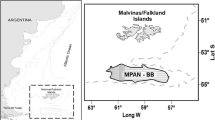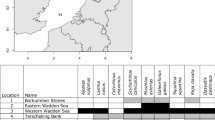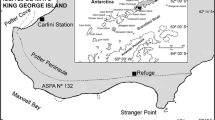Abstract
The coastline of the state of Rio Grande do Sul (Brazil) is used annually as a migratory route by a number of seabird species. Thirteen surveys were carried out between July 1997 and July 1998 to obtain information on the diet of Puffinus gravis, Puffinus griseus, and Puffinus puffinus along the coast of Rio Grande do Sul. Sampling efforts focused on dead beach-cast specimens. One hundred twenty-one stomach content analyses were performed on P. gravis from a total of 238 specimens; 17 stomach content analyses were performed on P. griseus from a total of 54 specimens; and 25 stomach content analyses were performed on 25 P. puffinus from a total of 61 dead specimens. Cephalopods were the main prey found in the stomachs of the three species and were present in 96% of the P. gravis stomachs. The following cephalopods were observed: Ommastrephidae, Gonatus antarcticus, Gonatus sp., Lycoteuthis lorigera, Lycoteuthis sp., Histioteuthis sp., Cycloteuthis sp., Loligo plei, Loligo sanpaulensis, Sepiidae, and Argonauta nodosa. The latter was the most abundant species in the three species of Puffinus. The following fish were identified from otoliths: Porichthys porosissimus, Ctenosciaena gracilicirrhus, Paralonchurus brasiliensis, Cynoscion guatucupa, and Trichiurus lepturus. There was also a high incidence of synthetic materials such as plastic, polyethylene and rubber.

Similar content being viewed by others
References
Abrams RW (1983) Pelagic seabirds and trawl-fisheries in the southern Benguela Current region. Mar Ecol Prog Ser 11:151–156
Auman HJ, Ludwig JP, Giesy JP, Colborn T (1998) Plastic ingestion by Laysan Albatross chicks on Sand Island, Midway Atoll, in 1994 and 1995. In: Robertson G., Gales R. (eds) Albatross: biology and conservation. Surrey Beatty, Chipping Norton, pp 239–244
Auman HJ, Woehler EJ, Riddle MJ, Burton H (2004) First evidence of ingestion of plastic debris by seabirds at sub-antarctic heard islands. Mar Ornithol 32:105–106
Barnes DKA, Milner P (2005) Drifting plastic and its consequence for sessile organism dispersal in the Atlantic Ocean. Mar Biol 146:815–825
Belton W (2000) Aves do Rio Grande do Sul: distribuição e biologia. UNISINOS, São Leopoldo, 584 p
Berrow SD, Croxall JP (1999) The diet of white-chinned petrels Procellaria aequinoctialis, Linnaeus 1758, in years of contrasting prey availability at South Georgia. Antarct Sci 11:283–292
Blight LK, Burger AE (1997) Occurrence of plastic particles in seabirds from the eastern North Pacific. Mar Pollut Bull 34:323–325
Boersma PD, Groom MJ (1993) Conservation of storm-petrels in the North Pacific. In: Vermeer KT, Briggs K, Morgan KH, Siegel-Causey D (eds) The status, ecology, and conservation of marine birds of the North Pacific. Can. Wilds Serv Spec Publ, Ottawa, pp 70–81
Boffo MS, Reis EG (2003) Atividade pesqueira da frota de média escala no extremo sul do Brasil. Atlântica Rio Grande 25:171–178
Borzone CA, Pezzuto PR, Marone E (1999) Oceanographic characteristics of a multi-specific fishing ground of the central south Brazil bight. Mar Ecol 20:132–146
Brown RGB, Barker SP, Gaskin DE, Sandeman MR (1981) The foods of great and Sooty Shearwaters Puffinus gravis and P. griseus in eastern Canadian waters. Ibis 123:19–30
Cadée GC (2002) Seabirds and floating plastic debris. Mar Pollut Bull 44:1294–1295
Campos EDJ, Lorenzzetti JA, Stevenson MR, Stech JL, Souza RB (1996) Penetration of waters from the Brazil–Malvinas confluence region along the South American continental shelf up to 23°S. Anais Acad Bras Cieˆncias 68:49–58
Cervigón F (1993) Los peces marinos de Venezuela, vol 2. Fundación Científica los Roques, Caracas, p 497
Chao LN (1978) A basis for classifying Western Atlantic Scianidae (Teleostei: Peciformes). Technical Report Circular 415, National Oceanic and Atmospheric Administration
Cherel Y, Klages N (1997) A review of the food of albatrosses. In: Robertson G, Gales R (eds) Albatross biology and conservation. Surrey Beatty, Chipping Norton, pp 113–136
Chirardia A (1991) Interação entre aves marinhas e cardumes de bonito listado (Katswonus pelamis) na costa sul do Brasil. Atlântica Rio Grande 13:115–118
Clarke MR (1986) Handbook for the identification of cephalopod beaks. Clarendon Press, Plymouth, 273 pp
Cooper J, Underhill LG, Avery G (1991) Primary molt and transequatorial migration of the sooty shearwater. Condor 93:724–730
Croxall JP (1987) Seabirds: feeding biology and role in marine ecosystems. Cambridge University Press, Cambridge
Croxall JP, Prince PA (1994) Dead or alive, night or day: how do albatrosses catch squid? Antarct Sci 6:155–162
Croxall JP, Prince PA (1996) Cephalopods as prey I. Seabirds. Philos Trans R Soc Lond B 351:1023–1043
Croxall JP, Hall AJ, Hill HJ, North AW, Rodhouse PG (1995) The food and feeding ecology of the white-chinned petrel Procellaria aequinoctialis at South Georgia. J Zool 237:133–150
Cruz JB, Lalas C, Jillett JB, Kitson JC, PO’B Lyver, Imber M, Newman JE, Moller H (2001) Prey spectrum of breeding sooty shearwaters (Puffinus griseu) in New Zealand. NZ J Mar Freshwat Res 35:817–829
Dahdul WM, Horn MH (2003) Energy allocation and postnatal growth in captive Elegant Tern (Sterna elegans) chicks: responses to high—versus low—energy diets. Auk 120:1069–1081
Duffy DC, Jackson S (1986) Diet studies of seabirds: a review of methods. Col Water 9:1–17
Fernandes LF, Brandini FP (1999) Microplankton communities in the Southwestern Atlantic Ocean: biomass and distribution in November/1992. Braz J Oceanogr 47:189–205
Furness BL, Laugksch RC, Duffy DC (1984) Cephalopods beaks and studies of seabird diets. Auk 101:619–620
Furness RW (1982) Estimating the food requirements of seabird and seal populations and their interaction with commercial fisheries and fish stocks. In: Cooper J (ed) Proceedings of the symposium on sea and shore birds. African seabird Group, Cape town, pp 1–14
Furness RW (1985) Ingestion of plastic particles by seabirds at Gough Island, South Atlantic Ocean. Environ Pollut Ser A 38:261–272
Furness RW (1994) An estimate of the quantity of squid consumed by seabirds in the eastern North Atlantic and adjoining seas. Fish Res 21:165–177
Furness RW, Monaghan P (1987) Seabirds ecology. Blackie, New York, p 164
Garcia AM, Vieira JP (2001) O aumento da diversidade de peixes no estuário da Lagoa dos Patos durante o episódio El-Niño 1997–1998. Atlântica Rio Grande 23:133–152
Godefroid RS, Spach HL, Junior RS, Queiroz GML (2003) A fauna de peixes da praia do balneário Atami, Paraná, Brasil. Atlântica Rio Grande 25:147–161
Griffiths AM (1982) Observations of pelagic seabirds feeding in the African sector of the Southern Ocean. Cormorant 10:9–14
Haimovici M, Andrigueto JMF (1986) Cefalópodes capturados na pesca de arrasto do litoral sul do Brasil. Arq Biol Tecn 29 39:473–495
Haimovici M, Perez JAA (1991) Coastal cephalopod fauna of southern Brazil. Bull Mar Sci 49:221–230
Haimovici M, Piatkowski U, Santos RA (2002) Cephalopod paralarvae around tropical seamounts and oceanic islands off the north-eastern coast of Brazil. Bull Mar Sci 71:313–330
Hamilton SA, Moller H, Robertson CJR (1997) Distribution of Sooty Shearwater (Puffinus griseus) breeding colonies along the Otago coast, New Zealand, with indication of countrywide population trends. Notornis 44:15–25
Harrison P (1983) Seabirds an identification guide. Houghton Mifflin Company, Boston, p 448
Horsman PV (1982) The amount of garbage pollution from merchant ships. Mar Pollut Bull 13:167–169
Hubold G (1980) Hydrography and plankton off southern Brazil and Rio de la Plata, August–November 1977. Atlantica Rio Grande 4:1–22
Hudson AV, Furness RW (1988) Utilization of discarded fish by scavenging seabirds behind whitefish trawlers in Shetland. J Zool (London) 215:151–166
Imber MJ (1992) Cephalopods eaten by wandering albatrosses (Diomedea exulans L.) breeding at six localities. J R Soc NZ 224:243–263
Jackson S (1988) Diets of the white-chinned petrel and sooty shearwater in the southern Benguela region, South Africa. Condor 90:20–28
Jackson S, Ryan PG (1986) Differential digestion rates of prey by white-chinned petrels (Procellaria aequinoctialis). Auk 103:617–619
Jangaard PM (1974) The capelin (Mallotus villosus): Biology, distribution, exploitation, utilization, and composition. Bull Fish Res Board Can 186:1–70
Jodice PGR, Roby DD, Hatch SA, Gill VA, Lanctot RB, Visser GH (2002) Does food availability affect energy expenditure rates of nesting seabirds? A supplemental-feeding experiment with Black-legged Kittiwakes (Rissa tridactyla). Can J Zool 80:214–222
Kitson JC, Cruz JB, Lalas C, Lillett JB, Newman J, PO’B Lyver (2000) Interannual variations in the diet of breeding sooty shearwaters (Puffinus griseus). NZ J Zool 27:347–355
Krebs CJ (1999) Ecological methodology. Benjamin cummings, New York
Lipinski MR, Jackson S (1989) Surface-feeding on cephalopods by procelariiform seabirds in the southern Benguela region. S Afr J Zool 218:549–563
Marchant S, Higgins PJ (1990) Handbook of Australian, New Zealand and Antarctic birds. Oxford University Press, Melbourne
Menezes NA, Figueiredo JL (1980a) Manual de peixes marinhos do sudeste do Brasil, II-Teleostei.. Universidade de São Paulo, Museu de Zoologia, São Paulo
Menezes NA, Figueiredo JL (1980b) Manual de peixes marinhos do sudeste do Brasil, IV-Teleostei. Universidade de São Paulo, Museu de Zoologia, São Paulo
Moser ML, Lee DS (1992) A fourteen-year survey of plastic ingestion by Western North Atlantic seabirds. Colonial Waterbirds 15:83–94
Olmos F (1997) Seabirds attending botton long-line fishing off southeastern Brazil. Ibis 139:685–691
Perez JAA, Martins RS, Santos RA (2004) Cefalópodes capturados pela pesca comercial de talude no sudeste e sul do Brasil. Notas Téc. FACIMAR 8:65–74
Petry MV, Fonseca VSS (2002) Effects of human activities in the marine environment on seabirds along the coast of Rio Grande do Sul, Brazil. Ornit Neot 13:137–142
Pierce KE, Harris RJ, Larned LS, Pokras MA (2004) Obstruction and starvation associated with plastic ingestion in a northern gannet Morus bassanus and a greater shearwater Puffinus gravis. Mar Ornithol 32:187–189
Pizzey G, Doyle R (1986) A field guide to the birds of Australia. Collins, Sydney
Prince PA, Morgan RA (1987) Diet and feeding ecology of Procellariiformes. In: Croxall JP (ed) Seabirds feeding biology and role in marine ecosystems. Cambridge University Press, Cambridge, pp 135–171
Pruter AT (1987) Sources, quantities and distribution of persistent plastics in the marine environment. Mar Pollut Bull 18:305–310
Ryan PG (1987) The effect of ingested plastic on seabirds: correlations between plastic load and body condition. Environ Pollut 46:119–125
Ryan PG (1988) Intraspecific variation in plastic ingestion by seabirds and the flux of plastic through seabird populations. Condor 90:446–452
Santos RA, Haimovici M (2000) The argentine shortfin squid Illex argentinus (Cephalopoda: Ommastrephidae) in the food webs off southern Brazil. Sarsia 85:49–60
Santos RA, Haimovici M (2002) Cephalopods in the trophic relations of southern Brazil. Bull Mar Sci 71(2):753–770
Shaffer SA (2004) Annual energy budget and food requirements of breeding wandering albatrosses (Diomedea exulans). Polar Biol 27:253–256
Shiomi K, Ogi H (1992) Feeding ecology and body size dependence on diet of the sooty shearwater, Puffinus griseus, in the north Pacific. Polar Biol 5:105–113
Sick H (1997) Ornitologia Brasileira. Nova fronteira, Rio de Janeiro, 862 pp
Skira IJ (1979) Underwater feeding by short-tailed Shearwaters. Emu 79:43
Thompson KR, Riddy MD (1995) Utilization of off-land discards from ‘finfish’ trawlers around the Falkland Islands by the Black-browed Albatross Diomedea melanophris. Emu 137:198–206
Vooren CM, Brusque LF (1999) As Aves do Ambiente Costeiro do Brasil: Biodiversidade e Conservação. Trabalho realizado para o Programa Nacional da Diversidade Biológica—PRONABIO, Subprojeto “Avaliação e Ações Prioritárias para a Zona Costeira e Marinha”, área temática “Aves marinhas”. Aves marinhas
Vooren CM, FernandeS AC (1989) Guia de albatrozes e petréis do sul do Brasil. Sagra, Porto Alegre, 99 pp
Weimerskirch H, Lys P (2000) Seasonal changes in the provisioning behavior and mass of male and female wandering albatrosses in relation to the growth of their chick. Polar Biol 23:722–744
Acknowledgments
We are grateful to the UNISINOS/UNESCO MAB agreement, which made the execution of the project possible; to Dr. Manuel Haimovici and the group from the Demersal Resources Laboratory of FURG for the cephalopod and otolith identification; and to our colleagues from the Laboratory of Ornithology and Sea Animals at UNISINOS.
Author information
Authors and Affiliations
Corresponding author
Additional information
Communicated by P.W. Sammarco.
Rights and permissions
About this article
Cite this article
Petry, M.V., da Silva Fonseca, V.S., Krüger-Garcia, L. et al. Shearwater diet during migration along the coast of Rio Grande do Sul, Brazil. Mar Biol 154, 613–621 (2008). https://doi.org/10.1007/s00227-008-0954-7
Received:
Accepted:
Published:
Issue Date:
DOI: https://doi.org/10.1007/s00227-008-0954-7




